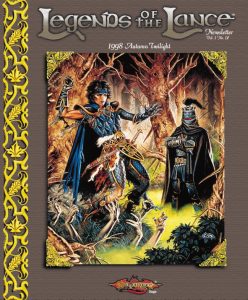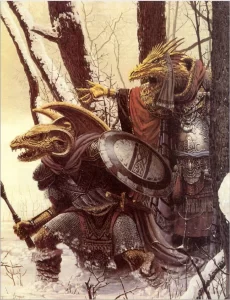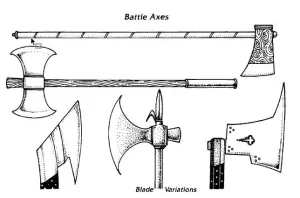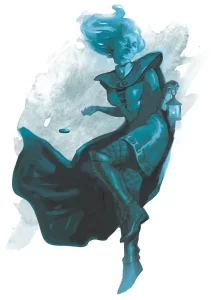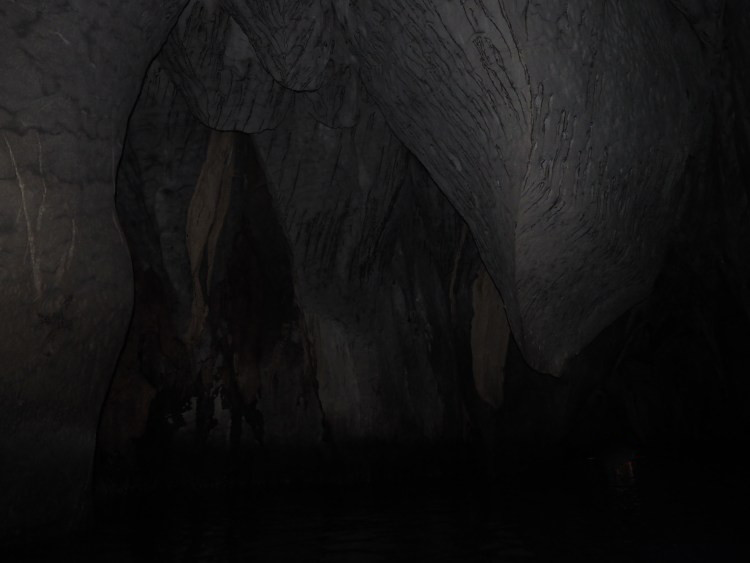
In role-playing games like Dungeons and Dragons, characters who cannot see in the dark run serious risks when participating in combat under these conditions. Such characters suffer a -4 penalty to all attack rolls, saving throws, and damage rolls, as well as a +4 penalty to Armor Class. Even with this penalty, a successful attack cannot cause less than 1 point of damage. Also, all bonuses that require a character to see his victim are forfeited. These include such abilities as a ranger's bonuses against giants, a thief's backstab attack, and a vorpal sword's beheading function.
Not only do characters who are unable to see have greatly reduced chances for success in combat, but they stand a chance of wounding an ally or striking some other obstacle in the darkness, or encountering treacherous terrain features such as cliffs, pits, or pools. These penalties do not apply to characters with infravision, nor to those wielding magical weapons or within range of any source of light.
If a character who cannot see is within twice his weapon length of any ally, other opponents, walls, chairs, or other obstacles, his attack stands a chance of striking one of these instead of his target. If the attack roll misses with a modified result of 0 or less, the attack has unintentionally struck another object. Any object closer to the character than twice his weapon's length may be hit. Count up all the objects within the weapon's reach, then roll randomly to determine which is hit. In addition, if a character who cannot see fights next to a drop off or on a sheer surface, his Dexterity is reduced by two for purposes of all Dexterity Checks to see if he falls over the drop-off, and his Climbing Rating is reduced by 10% for purposes of all Climbing Checks.
Spellcasting in Darkness
If a spellcaster cannot see the target of his spell, there is a chance that the spell might affect something besides the intended target. In these situations, the player must indicate exactly where the spell is targeted. The DM or GM then makes a secret roll on Table: Course Changes in Darkness to determine where the spell really goes off. If the spellcaster has a clue to the location of the target (noise or smell, for example), the DM or GM may assign a -1 to -3 modifier to the roll... .
| D12 Roll | Course Changes in Darkness |
| 1-3 | None, continue straight ahead |
| 4-5 | 45 degrees right |
| 6-7 | 45 degrees left |
| 8 | 60 degrees right |
| 9 | 60 degrees left |
| 10 | 90 degrees right |
| 11 | 90 degrees left |
| 12 | 135 degrees (1d6 1-3 right, 4-6 left |
Movement in Darkness
Although characters without the ability to see in the dark normally make every effort to provide themselves with a source of light underground, sometimes unforeseen situations can plunge a party into total darkness. Even characters with infravision have difficulty seeing objects that are the same temperature as the surroundings of the underearth.
This can be a very unsettling experience for a group of adventurers. The following effects can help recreate this situation for gaming. If characters, try to move at their normal movement rates in complete darkness, even probing the floor and walls ahead of them does not guarantee that the party avoids hazards. If a character encounters an obstacle while moving in darkness, he must make a Dexterity Check. Failure means that the character does not detect the obstacle in time to react, and his momentum carries him into it. Characters in the dark can safely move at 1/3 their normal movement rates. This pace is slow enough to keep the lead characters from blundering into any gaping holes in the floor or walking off the edge of a cliff. This also assumes that the characters are steadily probing the ground in front of them as they plod along.
Unless a character has some means of determining direction, such as trailing a hand along a corridor wall, it is virtually impossible to walk in a straight line in complete darkness. This is not usually an issue in narrow dungeon passages. On the wide-open but pitch-dark plains of some realms of the underearth, however, it is truly a formidable task for a character to keep his bearings about him. The DM or GM should make a secret roll on ld12 to determine the unknown changes of course that might occur if characters walk in complete darkness (see table above).


